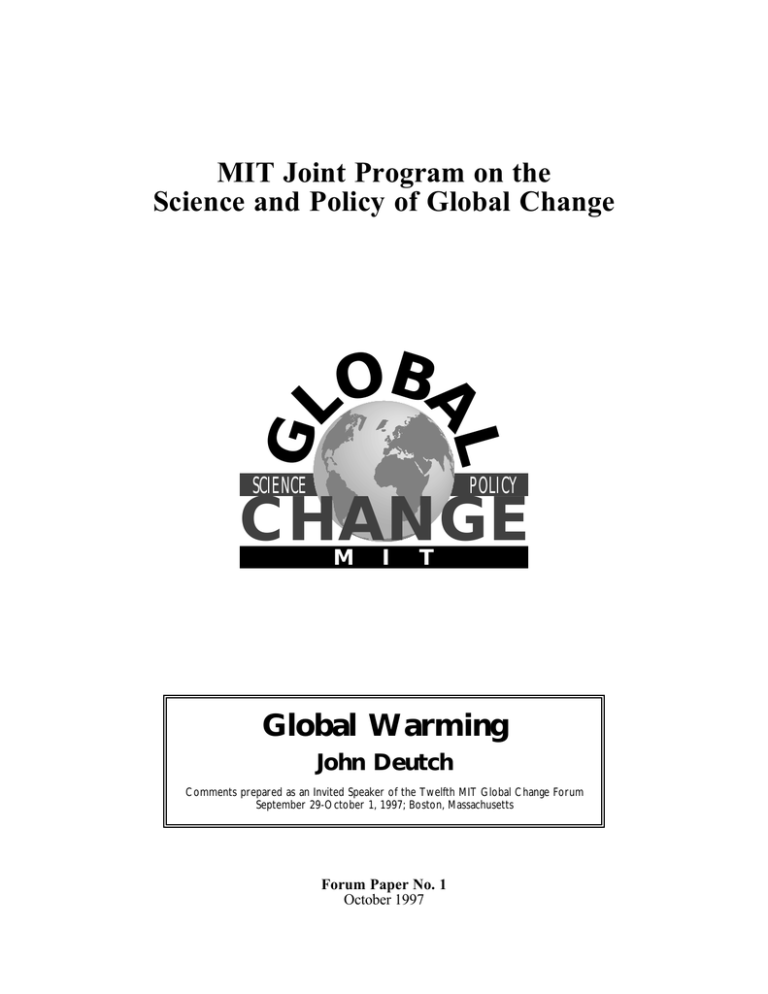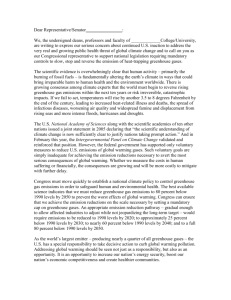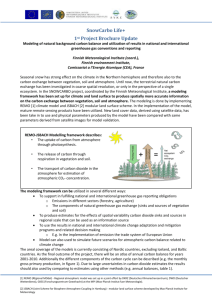G LO BA L
advertisement

MIT Joint Program on the Science and Policy of Global Change G AL B O L SCIENCE POLICY CHANGE M I T Global Warming John Deutch Comments prepared as an Invited Speaker of the Twelfth MIT Global Change Forum September 29-October 1, 1997; Boston, Massachusetts Forum Paper No. 1 October 1997 This Forum Paper is the first in a new series which will provide a means for the views of MIT Global Change Forum participants to reach a broader audience. The views expressed in this series are those of the author. Research results from the MIT Joint Program on the Science and Policy of Global Change are published in a separate Report Series. The MIT Joint Program on the Science and Policy of Global Change is an organization for research, independent policy analysis, and public education in global environmental change. It seeks to provide leadership in understanding scientific, economic, and ecological aspects of this difficult issue, and combining them into policy assessments that serve the needs of ongoing national and international discussions. To this end, the Program brings together an interdisciplinary group from two established research centers at MIT: the Center for Global Change Science (CGCS) and the Center for Energy and Environmental Policy Research (CEEPR). These two centers bridge many key areas of the needed intellectual work, and additional essential areas are covered by other MIT departments, by collaboration with the Ecosystems Center of the Marine Biology Laboratory (MBL) at Woods Hole, and by short- and long-term visitors to the Program. The Program involves sponsorship and active participation by industry, government, and non-profit organizations. Henry D. Jacoby and Ronald G. Prinn, Program Co-Directors For more information, contact the Program office: MIT Joint Program on the Science and Policy of Global Change Postal Address: 77 Massachusetts Avenue MIT E40-271 Cambridge, MA 02139-4307 (USA) Location: One Amherst Street, Cambridge Building E40, Room 271 Massachusetts Institute of Technology Access: Telephone: (617) 253-7492 Fax: (617) 253-9845 E-mail: globalchange@mit.edu Web site: http://web.mit.edu/globalchange/www Printed on recycled paper Global Warming John Deutch† Comments prepared as an Invited Speaker of the Twelfth MIT Global Change Forum September 29-October 1, 1997; Boston, Massachusetts I believe that what we know now about global warming justifies imposition of a modest tax on carbon emissions by the U.S. and other developed nations. This is a first step toward assuring that future generations will not find the concentration of atmospheric gases increased so much that it cannot be practically reversed before changes in the Earth’s climate cause calamitous damage. Gases in the atmosphere create a natural “greenhouse effect.” Atmospheric greenhouse gases permit shorter wavelength sunlight to pass through to hit the earth, while absorbing longer wavelength infrared radiation radiated from the earth to space. Since the industrial revolution, human activity has increased the concentration of carbon dioxide by about 35%, principally through the burning of fossil fuels—coal, oil, and natural gas—in power plants, motor vehicles, and industrial facilities. The weight of informed scientific opinion is that the Earth’s average temperature will increase by about 2 to 6.5 ˚F by the year 2100. If this anthropogenic effect turns out to be at the upper end of this range, the resulting increase in temperature will cause significant climate change around the globe. However, there are considerable uncertainties concerning the “greenhouse effect”: (1) the magnitude and timing of the temperature elevations in response to differing emission patterns; (2) the role of human influence relative to natural variability in the trend of increasing greenhouse gas emissions; (3) the regional pattern of climate change that is caused by the warming (it is likely to be greatest at higher latitudes and the poles); (4) the ability of ecosystems to adapt to the changed climate patterns; and (5) the costs of alternative policies to slow the pace of the anticipated global warming or to ameliorate its adverse social, environmental, and economic effects (if and when it occurs), for example, by protecting coastal areas threatened by flooding from higher sea levels. Effective action requires the concerted effort of all nations and involves significant economic costs. There exists no compelling political or economic rationale for allocating these costs among nations, for example, between developed nations whose past emissions have contributed the major portion of today’s atmospheric burden, and developing nations such as China, India, Brazil, Mexico, and Indonesia, whose anticipated future economic growth and energy use will account for the bulk of growth in emissions. Adjustments to more energy efficient and lower emitting means of production, for example, a shift away from electricity generated from coal, will have major economic impact, at least during a transition period. Not surprisingly, this prospective economic dislocation has prompted opposition from a broad industry coalition. As result, a July 25, 1997 U.S. Senate resolution (S. Res. 98) sponsored by Senators Byrd and Hagel, warns: No treaty would be ratified (1) that had a serious economic impact on the U.S.; (2) unless all countries (developed and developing) make commitments (not necessarily identical for all parties) for greenhouse gas reductions. Therefore, Congress will want to consider implementing measures before ratifying a treaty. In December 1997, in Kyoto, as a party to the 1992 Framework Convention on Climate Change, the United States is committed to enter into negotiations intended to culminate in a treaty † Institute Professor, Department of Chemistry, Massachusetts Institute of Technology, Cambridge, Massachusetts 02139 setting legally binding targets and a timetable for the reduction of greenhouse gas emissions. In these negotiations, the U.S. appears to have accepted two conditions adopted in Berlin in 1995 by Parties to the Framework Convention on Climate Change: First, quantitative emission limits will, at least initially, be applied only to developed nations and those developing nations who voluntarily agree to adhere. Second, the limits will specify that developed nations reduce emissions to 1990 levels at a yet to be determined future time, such as 2005 or 2010. The U.S. stresses the importance of maintaining flexibility in how each nation reaches its target, and shows great interest in allowing international trading of unused emission amounts within the permitted level. There is also considerable interest in the concept of “joint implementation,” where developed countries would obtain credits for investments in energy efficient and emission avoiding technologies in developing countries. These credits would permit developing countries to achieve industrial activity and economic growth with lower emissions than would otherwise be the case. Tradable international permits and “joint implementation” recognize the reality that the most attractive opportunities for cost/effective reduction of greenhouse gases are in the less-developed world. These measures are a sound theoretical way to achieve efficient allocation of desired emission reductions. The official U.S. position is a response in part to successful diplomatic pressure from Europe. European nations advocate adoption of targets below 1990 levels. Because of the collapse of industrial activity in Eastern Germany, the Soviet Union, and other Eastern European countries since the end of the Cold War, adoption of a 1990 baseline provides a windfall to Germany, Russia and other countries by awarding them excess permitted emission levels. Thus, a 1990 baseline benefits the European Community and Russia relative to the U.S., especially as compared to the adoption of a 1997 baseline. It is also worth noting that “joint implementation” would likely result in large capital transfers to China, which is already running a huge trade surplus with the U.S. Developing nations strongly believe they should not bear economic costs associated with reducing greenhouse emissions they did not create. In my opinion, the absence of adherence of the major developing nations to the proposed Convention makes the adoption of any target levels by developed countries unacceptable, even as a starting point for a lengthy process of evolution of international measures to meet the global climate threat. Developing nations are simply not going to agree to any constraints at present. Even if they did agree, there is little prospect many of these countries would or could enforce emission constraints. We cannot wait for significant narrowing of the national income gap between developed and developing nations to gain their commitment; for by that time, these nations will be emitting more greenhouse gases than today’s developed countries. Without global adherence, international tradable permits and joint implementation are unlikely to slow global emission growth, and there will be increased incentives for energy intensive industries to shift to unconstrained countries. There is a big difference between agreeing to target emissions in principle at an international conference and designing and adopting a practical target emission system for the U.S. (or other countries). This is not technically easy. Nor will it prove to be politically easy, because the public is being asked to make economic sacrifices today for uncertain collective benefit in the distant future. I suggest an alternative approach for the U.S.: First, the Administration places too much emphasis on reaching international agreement and pays too little attention to achieving the domestic consensus required for an effective control regime. The U.S. public does not now accept that global warming is a potentially significant 2 environmental threat. Most importantly, a greater effort should be made to convince industry and labor that current knowledge justifies some control measures, if only to establish the national and international mechanisms that might be needed, if the more pessimistic climate effects prove to be true. We need a continuous assessment process to adjust control measures depending on what we learn. However, during the next decade, there is unlikely to be sufficient progress, in scientific understanding or empirical observation, to narrow the significant uncertainties mentioned above. Second, the Administration must increase the priority on developing new technologies for greater efficiency in energy utilization and for alternative energy supply technologies that are less carbon dependent. While such research is unlikely to solve the global climate problem, the cumulative effect of innovation can lower the economic costs substantially. Such energy technology development inevitably must involve industry in a major way. The experience in response to the oil crisis in the U.S., Europe, and Japan in the late 1970s and early 1980s should remind US of the difficulty governments have of carrying out sustained research, development, and demonstration programs. We should not forget, however, that if the more pessimistic climate change estimates prove true, there will be an urgent need for alternative energy technologies, perhaps even nuclear based. Encouraging the dispersion of best practice technology, both domestically and internationally, is also important. Third, the Administration should propose an emission tax for the U.S. (and all industrialized countries) on carbon and, where practical, on other greenhouse gases, notably methane. The tax should initially be set at a level of about $10 per ton of carbon emitted, yielding revenue of about $10 billion per year. The tax amounts to less than 2.5¢ per gallon of gasoline, well below the $100 per ton which is estimated to be required for a market response shift adequate to reduce emissions to pre-1990 levels. The revenue raised from this tax should be used to reduce other taxes, or for three purposes: (1) to reduce the economic impact of job dislocation caused by the shift away from coal and other high carbon fuels; (2) to fund “joint implementation” projects in the developing world that would reduce carbon emissions below what they would otherwise have been; and (3) to stimulate new energy efficient technologies. There are several reasons for favoring a carbon tax over emission ceilings at present. First, a tax is simpler to administer and to adjust up or down depending on what is learned. Second, while a tax is sure to be unpopular with industry and labor, if properly structured, it is likely to be more popular than adoption of emission targets without adherence by the developing countries and in the face of the uncertainties. Beyond providing economic incentive, the tax will signal to industry the importance of reducing carbon emissions in the future. Third, the tax will generate revenue for the purposes mentioned above. Finally, a tax will demonstrate U.S. resolve to deal with global warming and may prove easier to negotiate internationally with developed and developing countries than a binding emission ceiling. For those who say with some justification, that a tax is politically unrealistic, I would remind them that the proposed target emissions involve a much larger, although slightly concealed, economic burden on U.S. citizens. In sum, the U.S. should propose a small carbon tax as an alternative to the current national emission targets on the table for Kyoto. It is a first step that is more consistent with the state of scientific knowledge and the extent of international consensus; and it is a first step that is more likely to be politically acceptable in the U.S. today. 3






